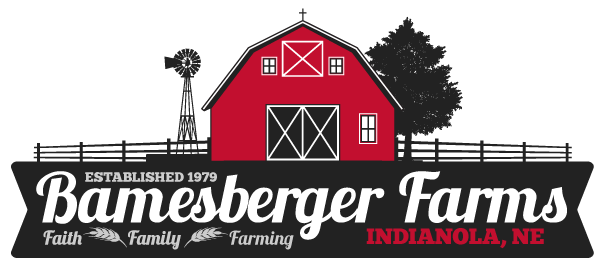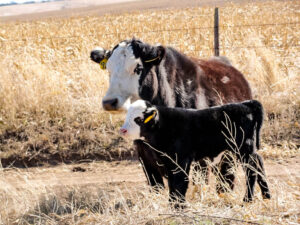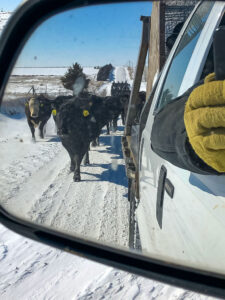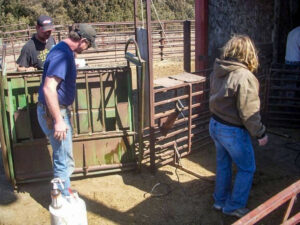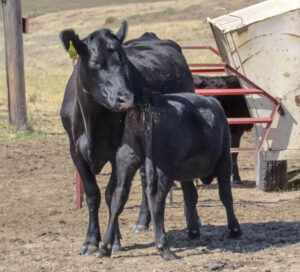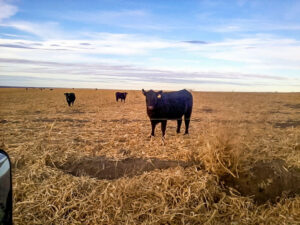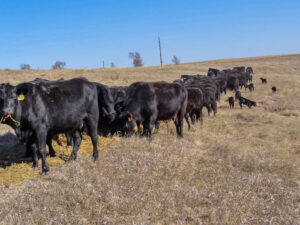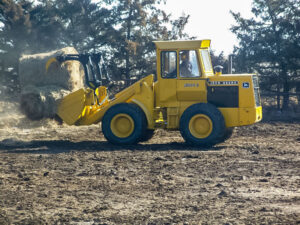Cow Herd

ABOVE: Cows have voracious appetites and will quickly flock to a fresh bale of alfalfa.
About the Herd
Our cow herd size varies somewhat but usually consists of around 400 black and black baldy mother cows. Due to the pasture sizes we split them into six or seven groups during the summer. Some of the larger groups we can rotate as some pastures border each other. On a normal year of good grazing, we give the cow/calf pair approximately nine acres each. When moving cows we use 4-wheelers, leading them with hay on the back of a pickup. Summer grazing starts around May 1st and ends in October.
Our calving date is March 1st and we are usually finished by the end of April. During this time, the cows are split in two groups. These groups then calve out on corn stock fields and adjoining off season grass. This varies year to year as corn fields change by rotation. It also helps prevent scour problems by rotating locations.
At birth we give a shot to the baby calves to prevent intertoximea, and give them a tag, numbered the same as their mother. Our cow tag numbering system include the first two digits being the year she was born (example 2051 cow would have been born in 2020). Before going to grass we process the calves, giving them a brand and a shot to prevent rhinotracheitis and respiratory viruses. The cows are also given a shot to prevent reproductive diseases and given a pour on which eliminates internal and external parasites.
Winter Grazing
With winter grazing we take about half of the herd to corn stalks near Minden Nebraska (100 miles east) and the ones we leave home utilize a our own corn stalks. To do this we build a temporary electric fence. The cows eat the ears of corn that fall on the ground prior or during harvest and the corn plant residue. The leaves usually blow away by spring anyway and any corn eaten cuts down on volunteer growing the next summer. We only graze the stalks down to about 50% residue remaining so there is still plenty for our no till program (check out more on quick links). During the last trimester we supplement alfalfa hay or protein tubs to provide nutrients missing in their diet to maintain good health prior to calving time.
Cow Management
Our heifer replacement program starts in the feedlot a few months after weaning time. The heifers we want to keep, either raised or purchased, are pelvic measured and Bangs vaccinated in January. Then a month before breeding we begin to synchronize them with a feed additive that prevents ovulation for two weeks, no additive for two weeks, then followed with an injection to get all the heat cycles aligned. At the scheduled time we artificially breed them and turn the bulls in for 30 days. We then ultrasound them for pregnancy around the 45th day. The heifers that did not get pregnant are then placed on feed, normally fitting into the later calves already at the feedlot.
All the cows are evaluated and culled for reasons of disposition, health, udder issues, or not with calf. Any cow failing in these categories are sent to the packing house in Gibbon Nebraska. The heifers entering our program replace these numbers. The bulls we purchase are from Registered Angus programs, targeting the top 1/3 of the herd offering.
Genesis 1:24-25
The Creation of the World
24 And God said, “Let the earth bring forth living creatures according to their kinds—livestock and creeping things and beasts of the earth according to their kinds.” And it was so. 25 And God made the beasts of the earth according to their kinds and the livestock according to their kinds, and everything that creeps on the ground according to its kind. And God saw that it was good.
